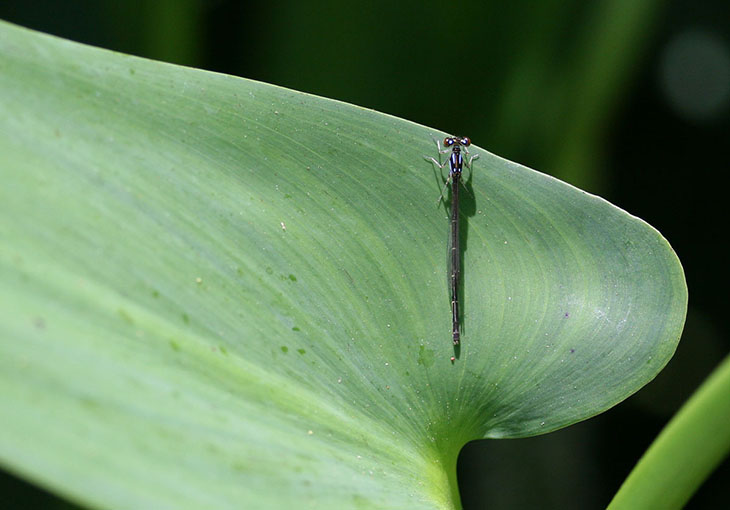
You know, if I’m telling you in the title that spiders will not be found in this post, that only means some following post is not going to be good for arachnophobes…
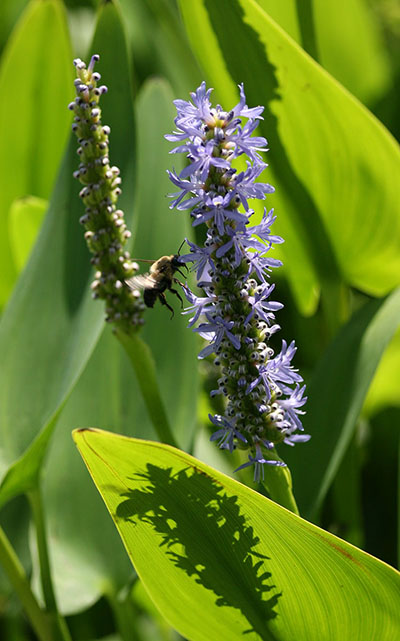 Since the move, I’ve been taking the opportunity on occasion to scope out the new area, trying to determine what kind of decent shooting locales can be found nearby. One stroke of luck is a large pond, close and easy to get to, but so far unspoiled. It’s big enough that it will serve as foreground interest for sunrises and passing storms, and is partially bordered by a great wetlands section. I expect it’s going to contribute a lot of images to my stock.
Since the move, I’ve been taking the opportunity on occasion to scope out the new area, trying to determine what kind of decent shooting locales can be found nearby. One stroke of luck is a large pond, close and easy to get to, but so far unspoiled. It’s big enough that it will serve as foreground interest for sunrises and passing storms, and is partially bordered by a great wetlands section. I expect it’s going to contribute a lot of images to my stock.
I’m going to be lazy this time around, and not worry about finding the proper species names for the subjects in this post – it’s time-consuming sometimes, and really messes with the flow of thoughts into charged silicon. So just cope with “bumblebee” and “flowering water plant” for this one, as I relate the special efforts I went through to capture the shadow of the bee against the leaf below. Even I imagined this to be an easy thing to capture, just taking a bit of patience, but that wasn’t really the case – the range the bee had to be in to cast a distinctive shadow on the leaf is pretty narrow, and bumblebees move fast and rather erratically. Of course, it takes finding a flower and leaf in just the right position in the first place, then staking it out and waiting for a bee to come along, hoping it wouldn’t take too long since the shadow would move off the leaf eventually. You’d like to think that a bee visiting the neighboring flower indicates that it’s just a matter of moments before it moves to the one you’ve chosen, but that comes from our structured, pattern-oriented, anal minds; bees don’t possess these traits. Planning shots like this can get you sunburned easily, and I wasted a lot of frames on near misses.
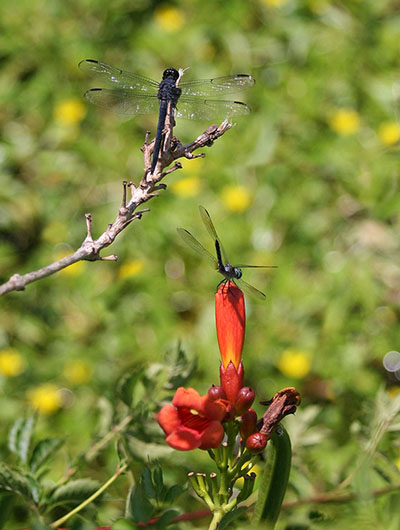 The pond area, unsurprisingly, plays home to a stunning number of dragonflies and damselflies (the difference between the two: the former has outstretched wings when sitting, like here, while the latter has wings aligned with their bodies like at the top of the post.) Both species need to have their wing muscles fairly warm to operate efficiently, which is why they perch in sunny areas so frequently, but this day was warm enough that they didn’t have to sit still very much. The one at top was cooperative and sat there for quite some time, while the pair seen here didn’t remain there together longer than 30 seconds before one or the other was off to pursue some tasty insect – they have no interest in bumblebees, by the way, and on those occasions when a dragonfly chose to perch atop one of the many flower spears, they were usually dislodged by bees within a few seconds. The nice thing about dragon/damselflies is that they often have preferred perches, and even when spooked off by an incautious movement from the photographer, may return quickly to the exact same spot. That allowed me to get these two together in the frame, though I admit this is actually a composite image. They were far enough apart in distance from the camera that one would be in focus while the other wasn’t, and stopping down to capture them together also sharpened the background to the point of being distracting and less appealing, so I combined two images where I had selected focus for either dragonfly. Shameless abuse of technology, I know.
The pond area, unsurprisingly, plays home to a stunning number of dragonflies and damselflies (the difference between the two: the former has outstretched wings when sitting, like here, while the latter has wings aligned with their bodies like at the top of the post.) Both species need to have their wing muscles fairly warm to operate efficiently, which is why they perch in sunny areas so frequently, but this day was warm enough that they didn’t have to sit still very much. The one at top was cooperative and sat there for quite some time, while the pair seen here didn’t remain there together longer than 30 seconds before one or the other was off to pursue some tasty insect – they have no interest in bumblebees, by the way, and on those occasions when a dragonfly chose to perch atop one of the many flower spears, they were usually dislodged by bees within a few seconds. The nice thing about dragon/damselflies is that they often have preferred perches, and even when spooked off by an incautious movement from the photographer, may return quickly to the exact same spot. That allowed me to get these two together in the frame, though I admit this is actually a composite image. They were far enough apart in distance from the camera that one would be in focus while the other wasn’t, and stopping down to capture them together also sharpened the background to the point of being distracting and less appealing, so I combined two images where I had selected focus for either dragonfly. Shameless abuse of technology, I know.
I have also returned to the pond at night, not really expecting to see much going on but curious as to how much light was in the area for night shots (too much – the nearby shopping complex and apartment buildings were liberally sprinkled with floodlights that reached all the way to the pond.) The cacophony of frog calls, however, was almost disturbing; I’ve misplaced my recorder in the move and so do not have any examples yet, but I’ll get one soon enough. I won’t even attempt to describe it, since I won’t be able to do it justice, and just let you hear it for yourself in a later post.
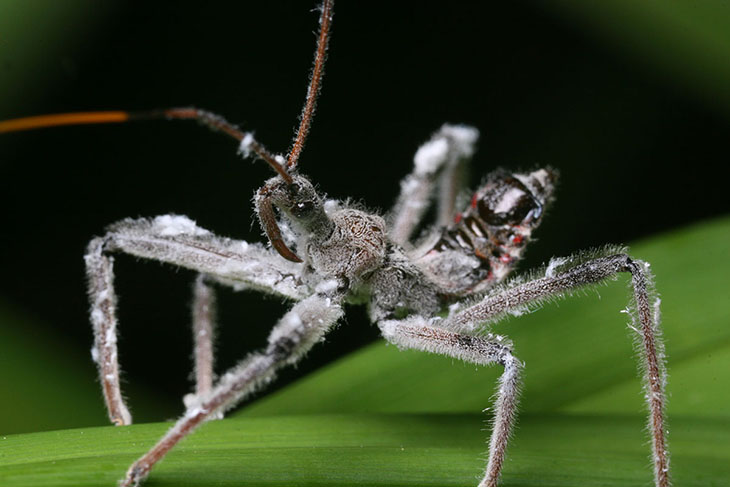
As should be apparent from previous posts, I’m not neglecting my immediate local surroundings either. Spotted in the backyard, an assassin bug nymph displays some atypical adornments; the white hairs are supposed to be there, the bits of fluff that make it look fresh from a pillowfight, not so much. But while I didn’t directly see how it achieved its ensemble, I’m pretty sure I know where it came from:

This variety of leafhopper nymph has been spotted numerous times nearby; this particular one was just coaxed out of the circle above where it had been sitting idly. I don’t pretend to know what that was all about, though I’d flushed it out since I thought it might be a variety of spider that I’d heard of but never seen, one that makes a white ‘splash’ of webbing on a leaf and then sits in the middle. With its green mottled markings, it looks very much like bird feces, and this appearance attracts flies for it to capture. Alas, this was only a fluffy leafhopper, not half as interesting even though those tendrils, when seen from above, certainly looked uniform enough for spider legs. Many local species of leafhopper extrude long, glassy tendrils from their hind ends, ‘feathers’ of starchy feces that may serve to distract predators by giving them a decoy to grab. That’s entirely different from what you see here, but it may be a related trait – like I said, I’m too lazy to look them up right now. Ask me nicely and maybe I’ll do a follow-up. But I consider this very likely to have contributed the lint to the assassin bug, especially since I saw the same effect on the legs of a crab spider a few weeks back, one that still had the leafhopper in its grasp. If it’s a defensive thing, it doesn’t seem to work all that well.
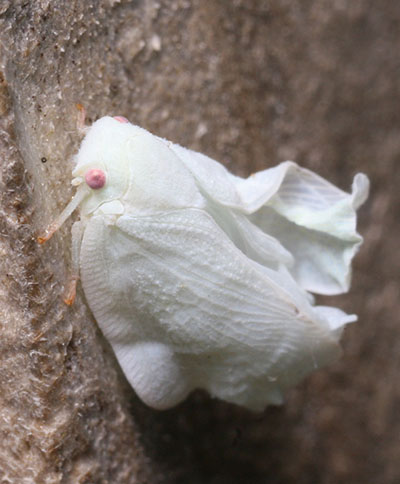 This is quite possibly the newly-molted adult form of the same leafhopper. At the very least, those wings look like they’re still drying and unfolding, but I didn’t spot the old exoskeleton anyplace nearby, so I can’t be sure. I even went back out a little later to see if the wings were fully-extended and dry by then, but couldn’t locate the leafhopper. As above, the eyes are red because these images were taken at night. Leafhopper eyes change color like praying mantis eyes do; during the day, they display a more camouflaging hue. Presumably, this provides some advantage to their night vision, but I suppose they could also be up well past their bedtime, or suffering from allergies – must maintain an open mind.
This is quite possibly the newly-molted adult form of the same leafhopper. At the very least, those wings look like they’re still drying and unfolding, but I didn’t spot the old exoskeleton anyplace nearby, so I can’t be sure. I even went back out a little later to see if the wings were fully-extended and dry by then, but couldn’t locate the leafhopper. As above, the eyes are red because these images were taken at night. Leafhopper eyes change color like praying mantis eyes do; during the day, they display a more camouflaging hue. Presumably, this provides some advantage to their night vision, but I suppose they could also be up well past their bedtime, or suffering from allergies – must maintain an open mind.
More pics will be along in a day or so – it’s been a fairly spidery couple of weeks. I’m kind enough, at least, to issue warnings. Sometimes.




















































